FRENCH SCUTTLE FLEET TO AVOID CAPTURE
Toulon Harbor, French Mediterranean · November 27, 1942
Between November 10 and 12, 1942, Germany and Italy engaged in a joint operation (German, Unternehmen Anton, or Case Anton) to occupy Marshal Philippe Pétain’s Vichy France, the French Riviera, and the French Mediterranean island of Corsica. These three areas comprised the so-called “Free Zone,” which was an arrangement by Pétain’s collaborationist French government headquartered at Vichy that allowed Southern France, unlike Northern and Western France, to avoid German occupation (see map below). However, following the Allied invasion of Vichy French North Africa on November 8, 1942 (Operation Torch), Adolf Hitler could not risk an exposed flank on the French Mediterranean; hence, Case Anton, planning for which had begun seven months earlier.
The Germans next formulated Operation Lila with the aim of capturing intact the demobilized Vichy French Mediterranean fleet at Toulon. (The Royal Navy had damaged some of the French Mediterranean fleet, killing and wounding nearly 1,650 seamen, on July 3, 1940, during the Battle of Mers-el-Kebir near Oran in French Algeria.) By order of the Admiralty of Vichy France, French naval commanders managed to delay the Germans by negotiation and subterfuge long enough to scuttle 77 ships on this date in 1942 before they could be seized, thus preventing 3 battleships, 7 cruisers, 15 destroyers, 12 submarines, 13 torpedo boats, and numerous auxiliary ships and tugs from falling into the hands of the Axis powers. (Four French submarines managed to escape the harbor.) Some of the scuttled ships burned for weeks and oil polluted Toulon’s harbor for years. French losses were 12 killed and 26 wounded.
The German Naval War Staff was miffed by French “perfidy.” Hitler, who earlier in the day had told Pétain that he could no longer trust French admirals (the commander of Vichy’s naval forces, Adm. François Darlan, had defected to the Allies in a secret agreement uncovered by the Germans), considered the elimination of the French fleet to have sealed the success of Case Anton. Also sealed was the fate of Pétain’s Vichy France, which had lost its last token of power and its credibility with the Germans.
![]()
French Scuttle Fleet in Reaction to Case Anton, the Military Occupation of Vichy France by Nazi Germany, November 1942
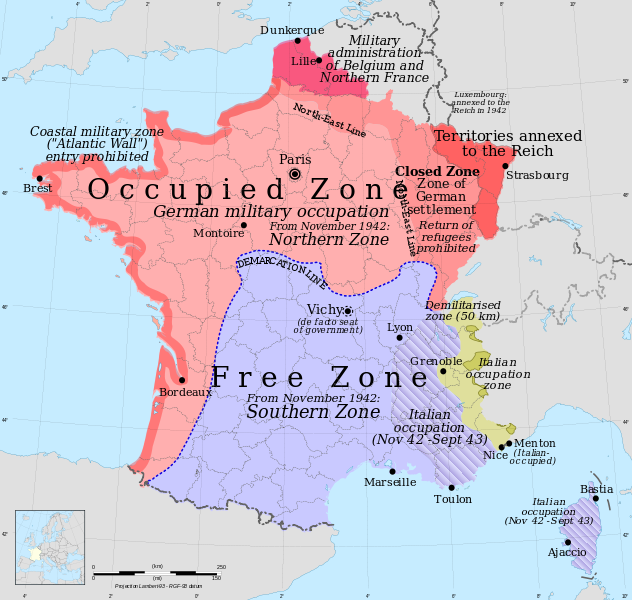 |
Above: Map showing German-occupied France (two-thirds of the country) and the remainder, the so-called Free Zone, or Vichy-administered France, which the Germans and Italians occupied in November 1942 (Case Anton) following Anglo-American landings on the south shore of the Mediterranean Sea in Vichy French North Africa. Green and purple-hatched areas in southeastern France designate the Italian occupation zone up to September 1943, when Italy signed an armistice with the Allies. The expanded Italian zone incorporated the Vichy naval port of Toulon and all of Provence and much of Rhône-Alpes to near Geneva, Switzerland, as well as the Mediterranean island of Corsica, birthplace of Napoleon Bonaparte.
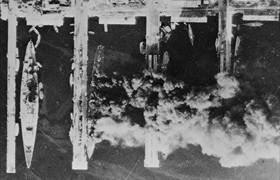 | 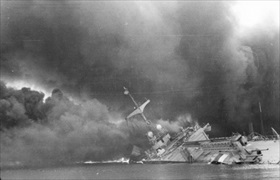 |
Left: The Vichy French scuttled all ships of any military value at Toulon, their large military harbor on the north shore of the Mediterranean coast, November 27, 1942. This aerial photograph, taken by the Royal Air Force the next day over the Quais de Milhaud harbor area, testifies to the thoroughness with which French seamen carried out their bitter task: Scuttled battleship Strasbourg (left) and cruisers Colbert, Algérie, and Marseillaise. The Strasbourg, whose bridge remained above water, capsized after a U.S. bombing attack on August 18, 1944. Free French Forces of Gen. Jean de Lattre de Tassigny captured Toulon ten days later.
![]()
Right: Probably the French light cruiser Marseillaise during the scuttling of the French fleet in Toulon. Anxious that the Germans should not capture his ship, the captain of the Marseillaise ordered scuttling charges to be set and the sea valves opened on one side. The ship slowly capsized as German soldiers watched from the docks. Explosions eventually ripped the vessel apart and fires took hold as the last French seamen abandoned ship. The ship’s officers were taken prisoner. The ship burned for seven days.
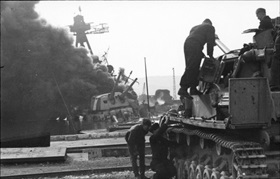 | 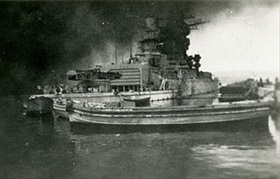 |
Left: Members of a motorcycle battalion from the 2nd SS Panzerkorps Das Reich inspect a Panzer IV medium tank, while in the background a French warship, probably the heavy cruiser Colbert, burns at its Toulon berth. (Terms of the Franco-German Armistice of June 1940 forbade German officers from boarding the demobilized French ships.) The cruiser was blown apart when her magazine exploded. The Colbert’s rusted hull remained on the sea floor until 1948, when her remains were scrapped.
![]()
Right: A photograph of the Strasbourg taken on November 28, 1942, at Toulon. The Italian Navy refloated the French flagship on July 17, 1943, but the armistice between Italy and the Allies in September 1943 halted these activities and the ship was taken over by the Germans. On April 1, 1944, the ship was returned to Vichy French authorities. Her wreck was then towed to the nearby Bay of Lazaret, where she was heavily bombed by U.S. aircraft and sunk three days after the start of Operation Dragoon, the August 15, 1944, Allied landings, as part of the preparations for the liberation of Toulon.
Brief German Newsreel from November 1942 Showing Scuttled French Fleet in Toulon (in English)
![]()

 History buffs, there is good news! The Daily Chronicles of World War II is now available as an ebook for $4.99 on Amazon.com. Containing a year’s worth of dated entries from this website, the ebook brings the story of this tumultuous era to life in a compelling, authoritative, and succinct manner. Featuring inventive navigation aids, the ebook enables readers to instantly move forward or backward by month and date to different dated entries. Simple and elegant! Click
History buffs, there is good news! The Daily Chronicles of World War II is now available as an ebook for $4.99 on Amazon.com. Containing a year’s worth of dated entries from this website, the ebook brings the story of this tumultuous era to life in a compelling, authoritative, and succinct manner. Featuring inventive navigation aids, the ebook enables readers to instantly move forward or backward by month and date to different dated entries. Simple and elegant! Click 











